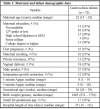Feeding Intolerance and Poor Growth in Infants with Gastroschisis: Longitudinal Experience with Consecutive Patients over Thirteen Years
- PMID: 26500852
- PMCID: PMC4617017
Feeding Intolerance and Poor Growth in Infants with Gastroschisis: Longitudinal Experience with Consecutive Patients over Thirteen Years
Abstract
Objectives: 1) To investigate in-hospital factors associated with delayed tolerance of full volume enteral nutrition and 2) To assess longitudinal growth in a contemporary population of infants with gastroschisis.
Design: Retrospective single-center study of all infants with gastroschisis Setting: Level III neonatal intensive care unit in a free-standing Children's Hospital Duration: 13.5 years
Materials & methods: Detailed data regarding demographics, nutritional support, growth, and infant outcomes was collected for all infants with gastroschisis. Linear regression was used to investigate in-hospital factors associated with feeding intolerance and poor growth.
Results: For 52 infants, the median gestational age at birth was 36 weeks, the median postnatal age to achieve full feeds was 22 days, and median in-hospital weight gain was 18 gm/day. With linear regression, there was a positive association between time to full feeds and both hospital length of stay (adjusted R2=0.503, p < 0.0001) and (unexpectedly) in-hospital weight gain (adjusted R2=0.125, p=0.0248). There was a negative association between in-hospital weight gain and preterm birth (adjusted R2=0.125, p=0.0356). For infants with longitudinal growth data, 35% had a weight < 5th percentile (of whom 67% were preterm).
Conclusions: Many infants with gastroschisis have poor growth before and after hospital discharge. Aggressive feeding advancement may be a contributing factor to this finding and preterm infants may be at greater risk for poor growth than term infants.
Keywords: Enteral nutrition; Gastroschisis; Growth; Preterm infant.
Figures




Similar articles
-
[Multicenter study of the nutritional status of premature infants in neonatal intensive care unit in China: report of 974 cases].Zhonghua Er Ke Za Zhi. 2009 Jan;47(1):12-7. Zhonghua Er Ke Za Zhi. 2009. PMID: 19573373 Chinese.
-
Gastroschisis Outcomes: Presence of Histologic Chorioamnionitis and the Impact on Time to Full Enteral Feeds and Length of Hospital Stay.Am J Perinatol. 2024 May;41(S 01):e1220-e1227. doi: 10.1055/s-0043-1761298. Epub 2023 Jan 29. Am J Perinatol. 2024. PMID: 36709758
-
Growth pattern of infants with gastroschisis in the neonatal period.Clin Nutr ESPEN. 2019 Aug;32:82-87. doi: 10.1016/j.clnesp.2019.04.008. Epub 2019 May 29. Clin Nutr ESPEN. 2019. PMID: 31221296
-
The significance of intrauterine growth restriction is different from prematurity for the outcome of infants with gastroschisis.J Pediatr Surg. 2004 Aug;39(8):1200-4. doi: 10.1016/j.jpedsurg.2004.04.014. J Pediatr Surg. 2004. PMID: 15300527 Review.
-
Dilute versus full-strength formula in exclusively formula-fed preterm or low birth weight infants.Cochrane Database Syst Rev. 2019 Jun 27;6(6):CD007263. doi: 10.1002/14651858.CD007263.pub3. Cochrane Database Syst Rev. 2019. PMID: 31246272 Free PMC article.
Cited by
-
Abdominal Wall Defects-Current Treatments.Children (Basel). 2021 Feb 23;8(2):170. doi: 10.3390/children8020170. Children (Basel). 2021. PMID: 33672248 Free PMC article. Review.
-
Factors Affecting Survival of Newborns with Gastroschisis from a Tertiary Care Children's Hospital in India.J Indian Assoc Pediatr Surg. 2025 Jul-Aug;30(4):491-496. doi: 10.4103/jiaps.jiaps_21_25. Epub 2025 May 7. J Indian Assoc Pediatr Surg. 2025. PMID: 40756050 Free PMC article.
-
Longitudinal growth of children born with gastroschisis or omphalocele.Eur J Pediatr. 2023 Dec;182(12):5615-5623. doi: 10.1007/s00431-023-05217-4. Epub 2023 Oct 11. Eur J Pediatr. 2023. PMID: 37819418 Free PMC article.
-
Neurodevelopmental outcome of patients with congenital gastrointestinal malformations: a systematic review and meta-analysis.Arch Dis Child Fetal Neonatal Ed. 2021 Nov;106(6):635-642. doi: 10.1136/archdischild-2021-322158. Epub 2021 Jun 10. Arch Dis Child Fetal Neonatal Ed. 2021. PMID: 34112720 Free PMC article.
References
-
- Holland A, Walker K, Badwi N. Gastroschisis: an update. Pediatr Surg Int. 2010; 26: 871-8. - PubMed
-
- Alvarez S, Burd R. Increasing prevalence of gastroschisis repairs in the United States: 1996-2003. J Pediatr Surg. 2007; 42: 943-6. - PubMed
-
- Vu L, Nobuhara K, Laurent C, Shaw G.Increasing prevalence of gastroschisis: population based study in California. J Pediatr. 2008; 152: 807-11. - PubMed
-
- Kassa A, Lilja H. Predictors of postnatal outcome in neonates with gastroschisis. J Pediatr Surg. 2011; 46: 2108-14. - PubMed
-
- Wood S, Samangaya R, Gillham J, Morabito A. Gastroschisis and the risk of short bowel syndrome: outcomes and counselling. Neonatol. 2014; 105: 5-8. - PubMed
LinkOut - more resources
Full Text Sources
Medical
